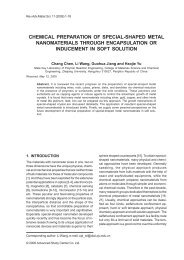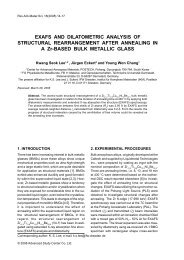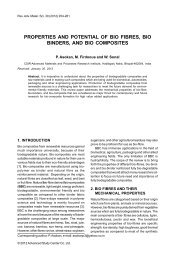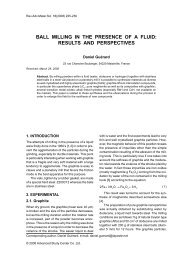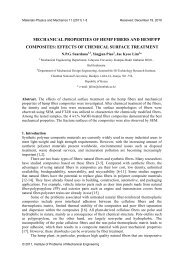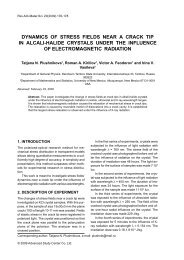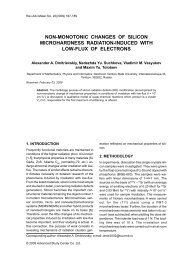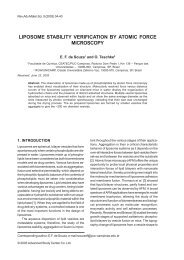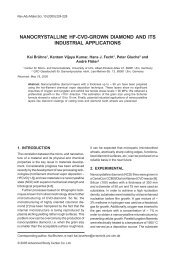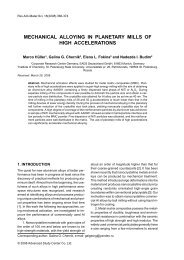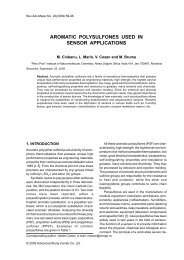surface pretreatment by phosphate conversion coatings – a review
surface pretreatment by phosphate conversion coatings – a review
surface pretreatment by phosphate conversion coatings – a review
Create successful ePaper yourself
Turn your PDF publications into a flip-book with our unique Google optimized e-Paper software.
148 T.S.N. Sankara Narayanan<br />
Mn 2+ ions demonstratably improve the corrosion<br />
resistance of <strong>coatings</strong> obtained from a low zinc phosphating<br />
process. The presence of Mn 2+ ions in low<br />
zinc phosphating bath increases the rate of formation<br />
of <strong>phosphate</strong> <strong>coatings</strong>. Hence, it is possible to<br />
decrease the bath temperature, which in turn allows<br />
a considerable amount of savings in the heating<br />
costs. Moreover, the addition of Mn 2+ ions in the<br />
phosphating bath helps to increase the working width<br />
of the phosphating bath. Also, the presence of manganese<br />
in the zinc <strong>phosphate</strong> coating resists the<br />
formation of white spots on galvanized steel. However,<br />
it is also cautioned that if the manganese content<br />
exceeds a certain level, a decrease in corrosion<br />
resistance may occur. Advanced analytical<br />
techniques have shown that the manganese tends<br />
to be distributed throughout the coating whereas<br />
nickel is concentrated at the interface and the presence<br />
of both contributes to maximum performance.<br />
Based on the results of the electron spin resonance<br />
(ESR) technique, Sato et al. [237] confirmed that<br />
both nickel and manganese are present in the zinc<br />
<strong>phosphate</strong> films respectively, as Ni(II) and Mn(II).<br />
According to them, the nickel and manganese doped<br />
hopeite are formed <strong>by</strong> the following mechanisms:<br />
Zn(H PO ) → ZnHPO + H PO , (4)<br />
2 4 4 3 4<br />
3Zn(H PO ) → Zn Me (PO ) . 4H2O + H PO . (5)<br />
2 4 3-x x 4 2<br />
3 4<br />
The chemical structure of the modified hopeite<br />
crystal in general was considered as<br />
Zn Me (PO ) . 4H2O, where Me = Ni or Mn.<br />
3-x x 4 2<br />
Accordingly, the chemical structure of the doped<br />
hopeite when nickel and manganese coexist is<br />
suggested as Zn (Ni Mn )(PO ) . 4H2O. The<br />
3-x-z x Z 4 2<br />
possibility of existence of such a structure was<br />
confirmed <strong>by</strong> various analytical techniques such as<br />
electron spin resonance (ESR), extended X-ray<br />
absorption fine structure (EXAFS), laser Raman<br />
spectroscopy, etc. [237-243].<br />
Besides the modification of the phosphating bath<br />
<strong>by</strong> Ni2+ and/or Mn2+ ions, developments were also<br />
made in modifying the <strong>surface</strong> of the steel sheets.<br />
The formation of a Fe-P coating of about 2 g/m2 containing a phosphorous content of 0.5% or below,<br />
on Zn-Ni or Zn-Fe steel sheets is another notable<br />
development [234, 244]. These materials are<br />
commonly known as double-layered Fe-P/Zn-Ni and<br />
Fe-P/Zn-Fe alloy plated steel sheets. The<br />
phosphatability of these steel sheets are highly<br />
comparable to that of cold-rolled steel sheets. It is<br />
the presence of micro quantity of phosphorous, uniformly<br />
dispersed in the iron <strong>coatings</strong>, which activates<br />
the <strong>surface</strong> and enhances the reaction with<br />
the phosphating bath, resulting in the production of<br />
closely packed phosphophyllite rich coating, having<br />
a crystal size of 3-5 mm. The formation of such<br />
a coating improves the wet adhesion property. Hence<br />
the modifications made in the phosphating formulations<br />
to produce <strong>coatings</strong> richer in phosphophyllite,<br />
to serve as an effective base for electrocoat finishing<br />
systems [225], are rightly justified.<br />
3.7. Influence of various factors on<br />
coating properties<br />
3.7.1. Nature of the substrate<br />
3.7.1.1. Composition of the metal. The presence<br />
of alloying elements and their chemical nature cause<br />
distinct difference in the extent of phosphatability of<br />
the substrate. It is generally believed that steels<br />
with small amounts of more noble metals such as<br />
chromium, nickel, molybdenum and vanadium can<br />
be <strong>phosphate</strong>d without much difficulty. However, if<br />
the concentration of these elements exceeds certain<br />
limit then the steel will encounter with a decrease<br />
in the intensity of acid attack resulting in a<br />
poor coating formation and among the noble metals<br />
in causing such an effect, chromium is considered<br />
to be the most detrimental one [245]. The<br />
phosphatability of cold rolled steel containing varying<br />
amounts of chromium, nickel and copper is given<br />
in Table 7. It is evident from Table 7 that the<br />
phosphatability is not affected when the total concentration<br />
of chromium, nickel and copper is in the<br />
range of 200-300 ppm and gets drastically affected<br />
when the total concentration of these metals exceeds<br />
800 ppm. The amount of carbon, phosphorus,<br />
sulphur, manganese and silicon can also influence<br />
the phosphatability of the steel to a great extent.<br />
Low carbon steels undergo phosphating easily<br />
and produce superior quality <strong>coatings</strong>. With increasing<br />
carbon content, the rate of phosphating<br />
becomes slower and the resultant crystals are<br />
larger. In fact, when dealing with the carbon concentration<br />
in steel, it is the distribution and the form<br />
in which it is present is rather an important criterion<br />
in predicting its probable effect on sensitization,<br />
nucleation and crystallization. The presence of ferrite<br />
crystals improve metal attack while on the other<br />
hand increasing concentrations of pearlite leads to<br />
coarsening of the <strong>phosphate</strong> crystals as the crystal<br />
nuclei develop only to a small extent on the islands<br />
of pearlite [127,246]. The deleterious effect of <strong>surface</strong><br />
carbon content has been the subject of many<br />
investigations and based on the amount of <strong>surface</strong><br />
carbon, steels have been classified as ‘bad’ or ‘good’<br />
with reference to their suitability to phosphating



